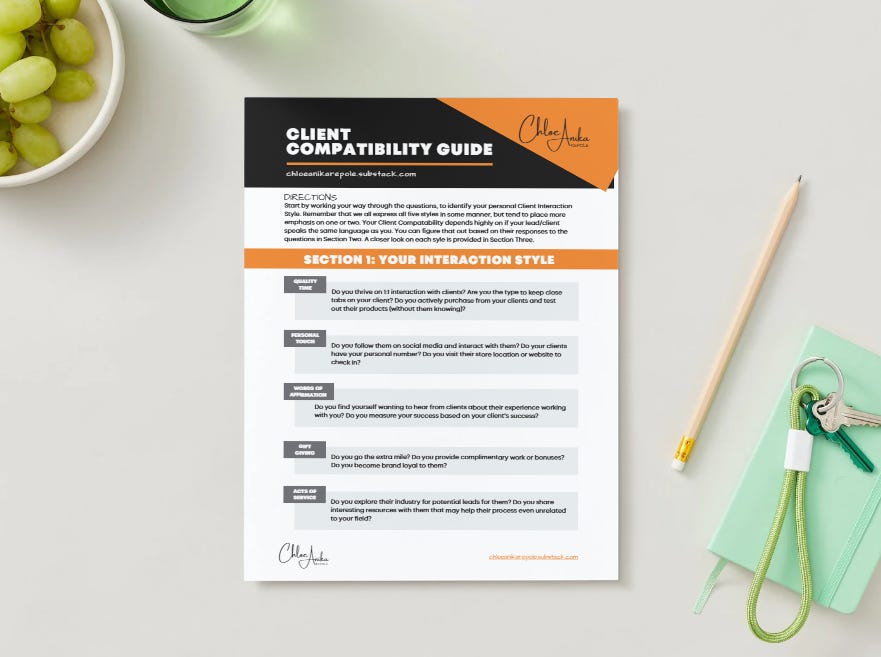Like most nuances of entrepreneurship, understanding client compatibility isn’t something you can learn from a textbook—it’s more of a battle scar earned through experience type of thing. Most service-oriented entrepreneurs come to know the subtleties of client relationships through a generous serving of trial and error, often seasoned with a side of stress.
I learned this the hard way in 2019 (and then again in 2023), after what I can only describe as a bad breakup with a client. It hit me—there had to be a better way to figure out who my ideal client is. If you’re anything like me, you get personally invested in your client relationships. These relationships are close and intimate—I give my time and energy, sacrificing personal moments with my kid. I become emotionally invested in their success, feel their losses, and share in their excitement.
There were times I tried to dial down my emotional investment for the sake of self-preservation, but I quickly realized that this is what makes me me. It’s what makes working with me a unique experience. I thought, if I give my clients the attention of a lover, friend, or family member, why not analyze the dynamic just as closely? That’s when Dr. Gary Chapman’s Love Languages practically shouted at me as a potential solution.
The Five Love Languages
In his 1992 book The Five Love Languages: How to Express Heartfelt Commitment to Your Mate, Chapman explains that people naturally want to receive appreciation and love in the same way they give it. He categorizes these expressions into five main areas:
Words of Affirmation
Gift Giving
Physical Touch
Quality Time
Acts of Service
Chapman suggests that to truly value someone, you need to understand their primary and secondary love languages. The same could apply to client relationships—why not prioritize the service provider’s experience, too?
That said, it’s worth noting that The Five Love Languages has faced its share of criticism over the years. Critics argue it oversimplifies human relationships, clings to outdated gender roles, and can sometimes put the burden of relationship success on the person doing the adapting. While not a perfect framework, I’ve found that when applied thoughtfully—and with a bit of a modern twist—it can still offer valuable insights into how we connect with clients.
What’s Your Love/Appreciation Language?
First things first: understand your own interaction and appreciation language. Ask yourself these questions to find your primary and secondary love languages:
Quality Time: Do you thrive on one-on-one interaction with clients? Do you keep close tabs on them, or even purchase and test their products on the sly?
Physical/Personal Touch: Do you follow them on social media and engage with their content? Do your clients have your personal number? Do you visit their store or website just to check in?
Words of Affirmation: Do you crave feedback from clients about their experience working with you? Do you measure your success by their success?
Gift Giving: Do you go the extra mile, offering complimentary work or bonuses? Do you become brand-loyal to them?
Acts of Service: Do you explore their industry for potential leads or share resources that might help their process, even if it’s unrelated to your field?
As you probably know all too well, having a client who doesn’t appreciate your effort stings—regardless of the whole “business is business” mantra. So why choose a client who doesn’t speak your language?
I asked myself if I could use the love languages not only to better understand my clients but also as a guide to identify and funnel ideal leads into specific service offerings. The answer was a resounding yes.
This approach can help service providers, especially coaches, consultants, and empathetic souls like myself, to better qualify, segment, and assess leads before they become clients. It’s about finding true compatibility—saving you time, effort, and potentially a lot of heartache.
Want to dig deeper?
I've put together a Free Client Compatibility Guide to help you assess potential clients through the lens of love and appreciation languages. Click here to download and start building more fulfilling, mutually beneficial client relationships today!






